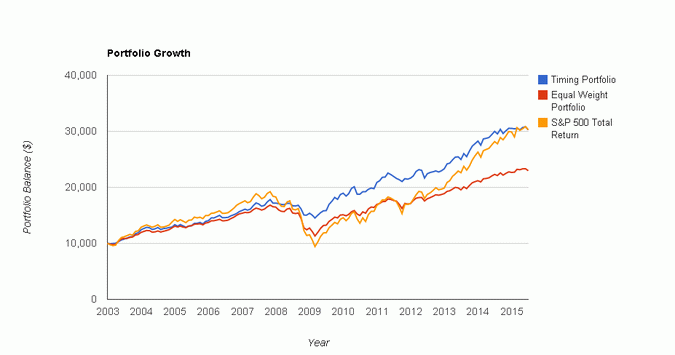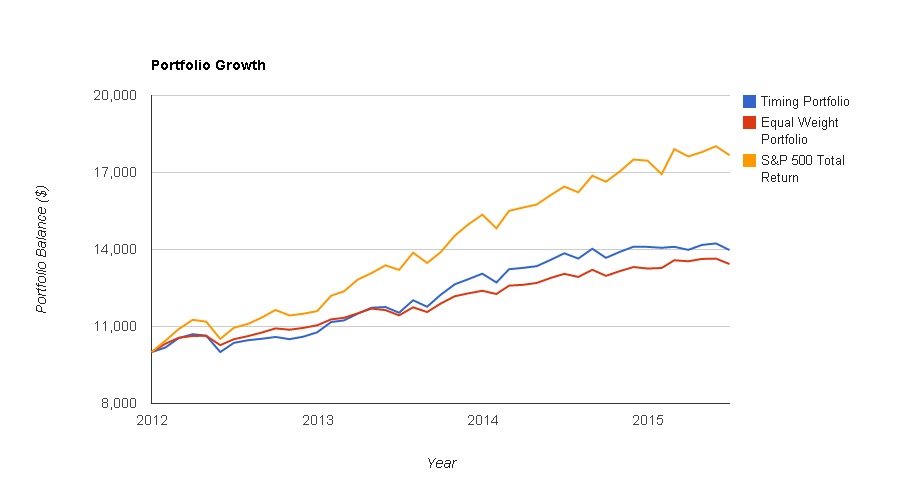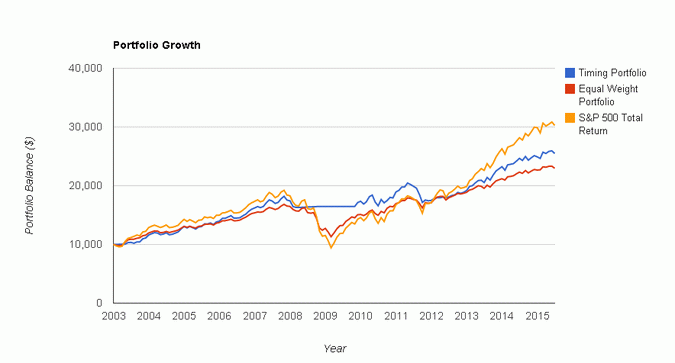Momentum strategies are popular because they are supposed to generate excess alpha at lower risk. However, as in the case with traditional trading strategies, momentum represents just another method that must be tested for significance and, more importantly, for intelligence in capturing alpha.
One cannot simply appeal to academic studies that demonstrate the momentum anomaly effect and then claim that there is a general method for transforming this effect into excess alpha. All trading hypotheses must be analyzed on a case-to-case basis. Part of the analysis could be testing the following hypothesis regarding backtested or even real performance:
H0: The method does not possess any intelligence
H1: The method possesses intelligence
By “possessing intelligence” it is meant here that a strategies was not curve-fitted on past data or was lucky in actual trading but that its returns were due to its ability to adjust to changing market conditions.
In general, testing strategies for intelligence is an edge in itself and separates winners from potential losers. Here is an example of testing the 50-200 golden cross strategies for intelligence. Note that this type of testing cannot be generalized, although some have unsuccessfully attempted that. It is a scientific process but it is also an art.
After this short introduction, I will use as an example a recent blog by Scott’s Investments blog about a strategy based on relative and dual momentum to demonstrate how backtest results can vary depending on selection of the starting date of the tests. This type of analysis is often part of the analysis done to test such methods for intelligence.
The tests in the mentioned blog were conducted using Portfolio Visualizer. In the referenced blog, a rotation strategy using four Vanguard allocation funds was shown to beat S&P 500 total return for the tested period. I will not show the original charts here as they are available in the reference. The test period was from 01/1996 to 07/2015 and a 5-month total return was used as the score. However, this is what happens when the starting date is changed to 01/2003 in the case of the relative momentum strategies:
Below are the detailed performance results:
It may be seen that the CAGR for the timing portfolio and S&P 500 total return are equal although drawdown is different. The performance shown is before any commissions and slippage.
Next I changed the starting date of this relative momentum strategy to 01/2012. Results are even more interesting:
It may be seen that the S&P 500 total return outperforms the relative momentum strategy by a wide margin of more than 7% annually and drawdown is about the same, as shown below:
The original report reflects (unintentionally) a test period with selection bias at work. What appears as significance outperformance in one test period changes to significant underperformance in another test period. The change in performance indicates that the results of this relative momentum strategy in the original test period from 01/1996 could be due to a curve-fit and such a strategy may lack intelligence to adjust to changing market conditions.
Let us also consider the dual momentum results. The mentioned blog also reported significance outperformance for the test period from 01/1996. This is what happens when the start date changes to 01/2003:
Below are the detailed performance results:
CAGR for dual momentum is about 150 basis points lower that S&P 500 total return but drawdown is lower due to diversification during the 2008 downtrend.
Next are dual momentum results with the test starting on 01/2012:
In this case the annual return for the dual momentum strategy was about 300 basis points less than S&P 500 total return at comparable drawdown.
Conclusion
If a fund manager shows you a nice backtest or even real results over a certain period of time, will you conclude that he has a sound trading or investing method? Actually, you should ask for detailed stress analysis that includes different time intervals and detailed quarterly results among other things. Momentum, relative, dual or whatever you may call it, has not performed as expected in recent years (other than in data-mined cases) because of several reasons that are beyond the scope of this blog. However, the most important of those reasons is that momentum strategies are not intelligent enough but represent a trivial way of trying to capture excess returns. The market has reacted in recent years to such trivial rotation schemes by refusing to let them generate excess returns. This is an ongoing process of eliminating the anomaly of trying to take advantage of a structural anomaly effect and the market is very good at this. Instead, the market is rewarding in recent years those that have put faith in the benchmark. I believe that momentum methods will soon join the ranks of problematic strategies. I am not saying this because I have something against these methods or the people that promote them. I say it because of experience. These methods remind me of how nicely moving average crossovers worked in the 1980s until they suddenly stopped, ruining many traders and funds. After all, it may be naive to think that it suffices looking at past returns for realizing future returns. That would be an extraordinary anomaly.
If you found this article interesting, I invite you follow this blog via any of these methods: RSS or Email, or follow us on Twitter
If you have any questions or comments, happy to connect on Twitter: @mikeharrisNY
Market signals from systematic strategies are offered in our premium Market Signals service. For all subscription options click here.














Vance Regan
Have you looked at the idea that Meb Faber mentioned about Ned Davis Research's 3 asset holding approach (Stocks, Bonds &Gold) based on the 3 &10 month MA's?
Michael Harris
Hello Vance,
I would think this is more of an asset allocation/diversification method than a system to capture just momentum premium in stocks. If you have a reference I may take a look at it and do some analysis.
Michael
Vance Regan
Hi Michael,
Here is the link to Meb's post:
http://mebfaber.com/2015/06/16/three-way-model/
I hope you have time to take a good look at it.
Vance
Michael Harris
Hi Vance,
Latest post is about some aspects of the 3-10 allocation scheme:
"Asset Allocation Models Based on Moving Averages Are Dumb"
Michael
Michael Harris
Fred,
I know the paper you cited. The paper I cited is a rigorous treatment as opposed to a series of appeals to other authorities (note that an appeal to authority is an informal logical fallacy) . Nevertheless, if you do not believe that the momentum premium has slowly disappeared in recent years, all you have to do is some analysis and it will be evident. Without including the 1990s bubble market, momentum backtests, long-only or long/short, can only exceed buy and hold with curve-fitting. This was also the case with the blog I mentioned here: take out the 1990s uptrend and the system does not outperform or underperforms the index. As someone commented in my Twitter account, momentum is a data-mined effect.
Can momentum premium reappear? Possibly if there is another bubble followed by a crash. For now this scenario is not highly possible.
Michael
Fred Dobbs
The Asness paper backs up all their claims with references to rigorous academic studies. Momentum was first presented by Cowles and Jones in 1937. It has held up well back to the year 1801 and up to the present. There is only one parameter to momentum – the look back period. Cowles and Jones used 12 months, and this parameter has held up out-of-sample going backwards and forward in time.
There are hundreds of academic papers documenting the efficacy of the momentum effect. Many academics and others were initially skeptical of momentum because it contradicted the efficient market hypothesis. But now it is universally accepted by academics. Even Fama and French call it the premier anomaly. If it had just been curve fit, they and others would never have accepted it.
Michael Harris
Hello Fred,
No one disputes a data-mined anomaly, because this is what momentum is actually, a data-mined affect. What I am disputing is that the data-mined anomaly can be turned into realistic and practical system that is intelligent enough to represent viable method for extracting alpha.
There is a lot of confusion lately due to the mixing of academic and trading papers under the same label. The academic papers prove that an effect exists, let us say the quantum entanglement effect in physics. The practical papers try to show how difficult it is to take advantage of this effect. For example, just to make an analogy here, no one disputes the entanglement effect in quantum mechanics. However, to this date, there are basically no useful applications.
Therefore, I do not care as a trader how many academics have shown that an effect exists, i.e., the momentum premium. I showed specific examples examples when the longer-term effect disappeared for an extended period of time. I sense that you dispute the backtests that showed that in a period of 12 years the momentum rotation system that had exceptional performance longer-term did not outperfrorm S&P 500 total return or that the 3.5 years since 2012 is a period investors in such scheme should not worry about the gross underperformnance.
At the end of the day, if a method does not perform well, can you wave an academic paper to the market and ask for your money back? I think you can't. But from your response I get the impression that you are actually waving those papers to all those who have been hit by the disappearing momentum premium in the last 10 years. They are not going to get their money back.
Michael
Fred Dobbs
Michael,
Even though by searching for a starting date that will support your belief, the momentum rotation system had the same return as the S&P500, the rotation system had a much higher Sharpe ratio and a drawdown that was less than half as large.
Maybe your view over the last 3 years has some validity, and maybe it's just normal randomness. I prefer to look at longer term histories as well as results over a range of parameter values. Only time will tell.
Michael Harris
Fred,
Actually I did not search for a starting date that supported my belief. That was a random choice helped by experience.
Yes, I agree, only time will tell.
Thanks for your input.
Michael
Michael Harris
Francisco,
That is a good idea but you may think of some reasons why that is not done. One is that the non-stationary nature of returns and Sharpe becomes evident.
Michael
Matt
Hi Mike – Which other backtester do you trust.
Thanks!
Michael Harris
Hello Matt,
I can speak only about those that I have tested and Price Action Lab, my software, generates code for. They are Amibroker and MultiCharts. However, there are several other backtesters available nowadays and some are probably as good. Note that each backtester has certain special features that must be understood before one can generate reliable results.
Michael
Fred Dobbs
Momentum has been shown to be valid and consistent all the way back to 1801 across different markets and with different parameters. This would seem to overcome any selection bias, right? Your statement that all trading hypotheses must be analyzed on a case-by-case basis can create the selection bias that you warn against. I don't see how your picking dates over just the past few years really shows anything other than that one can create negative as well as positive selection bias.
Michael Harris
Fred,
Nobody disputes the momentum effect.
"This would seem to overcome any selection bias, right?"
No when it comes to developing a specific method or system for exploiting the anomaly. I think this is the fine print here.
"Your statement that all trading hypotheses must be analyzed on a case-by-case basis can create the selection bias that you warn against."
Absolutely not. Trading hypotheses are not analyzed on the basis that some academic paper proved some effect exists. The analysis must show that the specific method or system to exploit this effect is robust and not random.
"I don't see how your picking dates over just the past few years really shows anything other than that one can create negative as well as positive selection bias."
I picked dates to show that results can vary depending on starting date. Are you denying this fact? I think you are not. This is an issue with robustness of trading strategies. Accounts invested in such schemes three years ago underperform. If the bull market continues for a few more years the underperformance will be major. What are you going to say to those people? Look, academic studies since the 1800s show that the anomaly exists? Are they going to eat the academic paper for launch during retirement? People should know the risks and selecting a suitable starting year often paints the wrong picture of a strategy. That's all. The strategy may be good but it must be shown with analysis.
Best.
Fred Dobbs
Michael,
That's why I think looking at a lot of data makes sense. Your starting date becomes much less important when you look at many years of past data instead of just a few years.
Michael Harris
Fred,
It depends on the data and what you are trying to prove. If there was a bubble market in the 1990s no matter where you start before it the results may be misleading because it is unlikely that there will be another bubble market of this kind in the near future. This is one problem of momentum backtests. The momentum premium was significant in the 1940s, 1960s and 1990s but since it is not. Usually what you say holds for strategies that do not rest on a specific anomaly with non-stationary characteristics. See this for example: http://ssrn.com/abstract=968176
Michael
Fred Dobbs
Michael,
Nothing works well all the time. It's difficult to draw conclusions that are relevant from the paper you cite since they were looking at long/short momentum rather than long-only momentum and mostly used a 6 month holding period when 1 month gives much better results.
They also say that most momentum profits come from the short side, and momentum is stronger among small caps. Asness et al show that neither of these statements are true. Asness also shows there is no evidence that momentum has weakened since it became well-known in the 1990s. http://papers.ssrn.com/sol3/papers.cfm?abstract_id=2435323
BacktestTrillionaire
One might argue that there is some selection bias in the dates chosen here also. Particularly 2012 as a starting point.
Michael Harris
Yes, that's exactly the point, i.e., there is a lot of selection bias. I'm glad someone got this right.:)
wkevinw
For long term timing, the "selection bias" time frames should be complete market cycles: from bear market lows to bear market lows or bull market highs to bull market highs. The methods underperform generally during the bull half cycles and outperform during the bear half cycles.
Good Luck
Michael Harris
Maybe so should we tell these money managers not to sell these products to customers during other times? I think this is another point.
Thanks
Francisco
Perhaps a rolling 3 or 5 years return would be more representative and reduce the date selection bias.